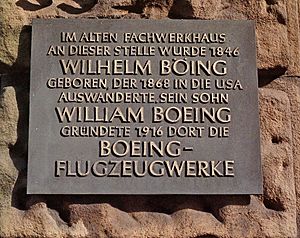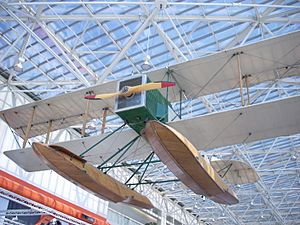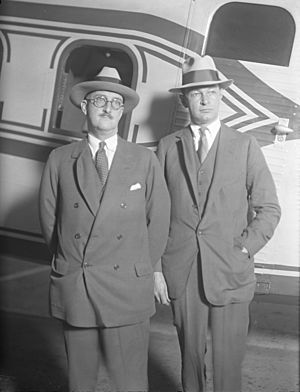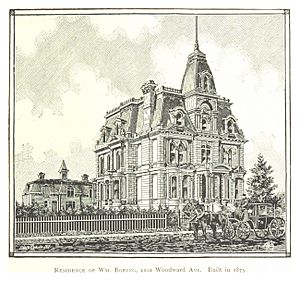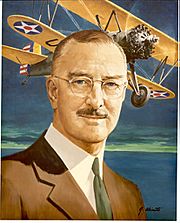William E. Boeing facts for kids
Quick facts for kids
William E. Boeing
|
|
|---|---|
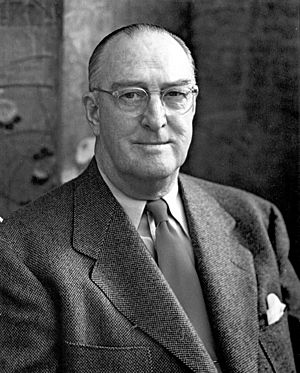 |
|
| Born |
William Edward Boeing
October 1, 1881 Detroit, Michigan, U.S.
|
| Died | September 28, 1956 (aged 74) Puget Sound, Washington, U.S.
|
| Nationality | American |
| Citizenship | American |
| Education | Yale University |
| Occupation | Industrialist |
| Known for | Founder of Boeing |
| Spouse(s) |
Bertha M. Potter Paschall Boeing
(m. 1921) |
| Children | William E. Boeing Jr. |
| Awards | Daniel Guggenheim Medal (1934) |
| Signature | |
 |
|
William Edward Boeing (born October 1, 1881 – died September 28, 1956) was an American aviation leader. He started the Pacific Airplane Company in 1916. One year later, this company became known as The Boeing Company. He also helped create the United Aircraft and Transport Corporation in 1929, which is now called United Airlines. William Boeing served as the chairman of this new company.
Contents
William Boeing's Early Life
William Boeing was born in Detroit, Michigan. His mother, Marie M. Ortmann, was from Vienna, Austria. His father, Wilhelm Böing, was from Hohenlimburg, Germany. Wilhelm Böing moved to the United States in 1868. He started with no money from his family. Later, he earned a lot of money from timber lands and iron ore in Minnesota.
In 1890, when William was eight, his father died from the flu. His mother remarried soon after. William went to school in Vevey, Switzerland. He then returned to the U.S. for a year of prep school in Boston. He later studied at Yale University in New Haven, Connecticut. In 1903, he left college to work in the lumber business.
Boeing's Career Journey
William Boeing moved to Hoquiam, Washington, in the Pacific Northwest. He bought a lot of timberland near Grays Harbor. He started the Greenwood Timber Company. This business was very successful. He shipped lumber to the East Coast using the new Panama Canal. This success gave him money to start a new kind of business.
How Boeing Became Interested in Airplanes
In 1909, William Boeing visited the Alaska-Yukon-Pacific Exposition. There, he saw a flying machine for the first time. He became very interested in aircraft. He took flying lessons at the Glenn L. Martin Flying School in Los Angeles. He even bought one of Martin's planes.
A pilot named James Floyd Smith came to Seattle to put Boeing's new Martin hydroaeroplane together. He also continued to teach Boeing how to fly. The plane parts arrived by train. Smith assembled the plane in a tent hangar near Lake Union. Soon, Boeing's test pilot, Herb Munter, damaged the plane.
Martin told Boeing that new parts would take months to arrive. Boeing then told his friend, Commander George Conrad Westervelt of the US Navy, "We could build a better plane ourselves and build it faster." Westervelt agreed. They soon built the B & W Seaplane. This was a biplane that could land on water and had great performance. Boeing decided to start an aircraft business. He used an old boat factory on the Duwamish River near Seattle as his first factory.
Starting the Boeing Airplane Company
In 1916, Boeing partnered with George Conrad Westervelt. They named their first plane "B & W." They started a company called Pacific Aero Products Co. Their first plane was the Boeing Model 1 (B & W Seaplane). When America joined World War I on April 8, 1917, Boeing changed the company name. It became the Boeing Airplane Company. They received orders from the US Navy for 50 planes. After the war, Boeing focused on planes for carrying mail.
First International Airmail Flight
On March 3, 1919, William Boeing and Eddie Hubbard made history. They completed the first delivery of international airmail to the United States. They flew a Boeing C-700 seaplane. This special flight went from Vancouver, British Columbia, to Seattle's Lake Union. They carried a bag with 60 letters from the Canadian post office for delivery in the U.S.
Breaking Up the Boeing Group
In 1929, Boeing and Frederick Rentschler of Pratt & Whitney created a new company. It was called United Aircraft and Transport Corporation. This new company wanted to be involved in all parts of aviation. It bought many smaller airlines. These were then combined with Boeing's own airline under a larger company called United Air Lines.
In 1934, the U.S. government accused William Boeing of unfair business practices. In the same year, a law called the Air Mail Act was passed. This law made airplane companies separate their flight operations from their plane building. William Boeing gave up his ownership. His company, United Aircraft and Transport Corporation, split into three separate parts:
- United Aircraft Corporation, which built planes in the eastern U.S. (later United Technologies Corporation)
- Boeing Airplane Company, which built planes in the western U.S. (later The Boeing Company)
- United Air Lines for flying planes and carrying passengers or mail
William Boeing's Family Life
In 1921, William Boeing married Bertha Marie Potter Paschall. Bertha already had two sons, Nathaniel Jr. and Cranston Paschall, from a previous marriage. William and Bertha had one son together, William E. Boeing Jr. (1922–2015). Both of William's stepsons also worked in aviation. Nat Paschall became a sales manager for Douglas Aircraft, another plane company. Bill Jr. became a private pilot and worked in real estate.
Views on Housing and Society
William Boeing and his wife Bertha had certain views on how communities should be organized. Between 1935 and 1944, they bought a large area of land north of Seattle. They planned to build homes there. The Boeings put rules in place for these properties. These rules said that properties could not be sold or rented to anyone who was not of the "White or Caucasian race." People who were not white could only live on the property if they worked as a servant for a white family.
Later Years and Passing
In his later years, William Boeing became a property developer. He bought a 650-acre farm east of Seattle. He called it "Aldarra." This estate stayed in his family until 2001. Most of the land was then turned into a golf course and homes. However, some acres, including the Boeing family's main house and two smaller houses, remained with the family. His main home for most of his life was a large house in The Highlands community near Seattle. This house, the William E. Boeing House, is now a historic place. Boeing Creek, a stream near this property, is named after him.
William Boeing passed away on September 28, 1956. He was 74 years old, just three days before his 75th birthday. He had a heart attack on his yacht, Taconite, in Puget Sound, Washington. He was pronounced dead when he arrived at the Seattle Yacht Club. His ashes were spread off the coast of British Columbia, where he loved to sail.
In 2005, his son, William Boeing Jr., shared some thoughts about his father: "He loved watching birds, believed in reducing risk by focusing on facts and realized long before other people that commercial aviation had a place on the globe. He was someone who pursued his curiosity, studied things carefully and never dismissed the novel."
Interesting Facts About William Boeing
- The Boeing Company is now the largest exporter in the United States by dollar value. It is also one of the biggest airplane makers in the world.
- William Boeing's first plane design was the Boeing Model 1 (or B & W Seaplane). It first flew in June 1916.
- Ten years after his death, in 1966, he was honored. He was added to the National Aviation Hall of Fame in Dayton, Ohio.
- He received the Daniel Guggenheim Medal in 1934 for his work in aviation.
- Before building airplanes, Boeing had experimented with designing boats.
- Boeing loved horses. After 1937, he spent most of his time raising thoroughbred horses.
- On May 14, 1954, William Boeing and his wife Bertha returned to the Boeing Airplane Company. They attended the event for the new Boeing 367-80 prototype plane.
- The Museum of Flight in Seattle keeps William E. Boeing Sr.'s papers. This collection includes his writings and photographs.
- In 1984, Boeing was added to the International Air & Space Hall of Fame at the San Diego Air & Space Museum.
William Boeing's Famous Quotes
- "Science and hard work can lick what appear to be insurmountable difficulties."
- "We are embarked as pioneers upon a new science and industry in which our problems are so new and unusual that it behooves no one to dismiss any novel idea with the statement that ‘it can’t be done!’"
- "I've tried to make the men around me feel… that we are embarked as pioneers."
Images for kids
See also
 In Spanish: William E. Boeing para niños
In Spanish: William E. Boeing para niños


